Jaipur
Thursday 23 December – Saturday 25 December
1999
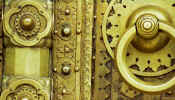 India
doesn't really seem like a country or even a sub-continent; it seems much
bigger. To put it in perspective,
Lonely Planet’s guide to India is a whopping 1,263 pages long, and even that
only gives you an overview of the main areas of interest to tourists.
And we knew
travelling here would be tough: that the
poverty and crowds would wear us down; that Indian bureaucracy would test us to the limits of
our patience; and that the
seemingly endless railway journeys would bore us to tears.
Expecting the worst, we were
India
doesn't really seem like a country or even a sub-continent; it seems much
bigger. To put it in perspective,
Lonely Planet’s guide to India is a whopping 1,263 pages long, and even that
only gives you an overview of the main areas of interest to tourists.
And we knew
travelling here would be tough: that the
poverty and crowds would wear us down; that Indian bureaucracy would test us to the limits of
our patience; and that the
seemingly endless railway journeys would bore us to tears.
Expecting the worst, we were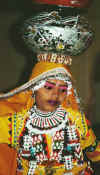 somewhat pleasantly surprised by our first train
journey from Delhi to Jaipur; the
train left on time, our tickets were valid, the seats were a bit dilapidated but
serviceable, and the meal was edible. It was a promising start.
somewhat pleasantly surprised by our first train
journey from Delhi to Jaipur; the
train left on time, our tickets were valid, the seats were a bit dilapidated but
serviceable, and the meal was edible. It was a promising start.
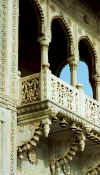 Jaipur is the capital of
Rajasthan. Surrounded by arid,
barren hills, it’s a vibrant place with a delightful quantity of pink-coloured
buildings. The streets are
bristling with camels and oxen pulling carts laden with all manner of things.
They are joined by a crazy mix of rickshaws, bicycles, trucks, buses,
motorcycles and death-defying pedestrians. Nearby
is a profusion of impressive fortress-palaces. The Maharajas of Rajasthan
were renowned for their
valor, but judging from these palaces they liked their comforts as well as their
conflicts.
Many of the structures contained beautiful carvings, mosaics, inlaid
panels, sculptures and coloured glass windows.
Very impressive.
Jaipur is the capital of
Rajasthan. Surrounded by arid,
barren hills, it’s a vibrant place with a delightful quantity of pink-coloured
buildings. The streets are
bristling with camels and oxen pulling carts laden with all manner of things.
They are joined by a crazy mix of rickshaws, bicycles, trucks, buses,
motorcycles and death-defying pedestrians. Nearby
is a profusion of impressive fortress-palaces. The Maharajas of Rajasthan
were renowned for their
valor, but judging from these palaces they liked their comforts as well as their
conflicts.
Many of the structures contained beautiful carvings, mosaics, inlaid
panels, sculptures and coloured glass windows.
Very impressive.
On Christmas Eve day, Pippa had
a tearful reunion with her parents and brother, and that evening we were
entertained with a puppet show and local dancing at our hotel around huge
outdoor fires. The next day, after a brief present-exchanging ceremony, we
went out to explore Jaipur on foot and joined the confusion of traffic, people
and animals crowding the streets. The
old city was fun to explore, in all its pink glory, and we only got lost once.
Pushkar
Sunday 26 December 1999
From Jaipur, Pippa’s mother
and father headed west to Jaisalmer, whilst Jeremy joined us on a southern loop
via Udaipur. We would all meet up again in Jodhpur to welcome in the new
millennium.
By far the quickest way to cover
the ground we wanted to in the space of four days was to hire a car and driver.
However, travelling on Indian roads was not for the faint-hearted; one
had to consider the condition of the roads and vehicles, the prevailing speed of
traffic, the cattle who acted like they owned the road, and the driver's code of
honor. The latter could be summed up as
"never be passed, never yield", and amounted to a big game of
chicken. It was taken very seriously
But car was definitely the way
to go and, despite the white-knuckle ride, it allowed for a first rate view of
the scenery through which we passed. We
marveled daily at Jerry who, brave enough to occupy the front seat, sat reading
his way through the entire journey and flinched only at the very worst of the
near-miss collisions we encountered (and there were indeed many).
Having said that, we arrived at Pushkar safe and sound, ready for some
major sight-seeing.
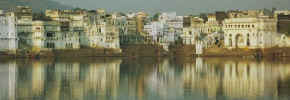
For Hindus, Pushkar is a very
important pilgrimage centre and we saw many sadhus here: holy men on a
spiritual search, with ash covered bodies and matted hair, carrying little more
than a water bowl and clad only in simple loincloths.
We knew that Pushkar would be a highly religious place, complete with ghats
(landings or steps to the water) and temples, but we were still slightly taken
aback to discover that not only was possession, sale or consumption of any
alcohol banned, but also meat and even eggs.
But we had not come to Pushkar
to sample their culinary delights, and so as soon as we had found a place to
stay, we headed down to the lake to watch the afternoon and evening unfold.
The town surrounded Pushkar Lake on two sides.
Steep flights of steps ran down from the road to the lakeside ghats, but
any footwear had to be removed before starting the descent: not an enticing
prospect looking at the piles of cow dung and bird poop covering the stone (not
to mention the hoards of flies and intermittent rats scurrying across).
Here, pilgrims of all ages could be seen bathing in the lake’s holy
waters and carrying out different kinds of ceremonies involving flower petals,
prayer chants and splashing water over certain parts of the body.
Jerry wasn’t that keen to hang around given the restriction on smoking
and the unsavory feel of the stone underfoot, so we walked across to the other
side of the lake and sat on the shores there, watching the sun set over the
skyline and observing the continuing rituals unfold at the water’s edge across
from us.
As we wandered through the
bazaar that night, marveling at the sights, sounds and colors around us, we felt
the mystery of this enchanting town. True,
it had become very touristy and 'traveler-friendly', with shops
selling pajama-bottom type trousers and restaurants listing banana pancakes as
their specialty, but it had not lost its charm and we delighted in wandering
through the streets, happening upon old havelis (rich merchants' houses)
and taking in the nighttime hubbub.
Udaipur
Monday 27 December - Tuesday 28 December 1999
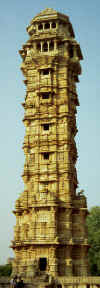 The
next day we continued our car journey, this time heading south to Udaipur. It took us the whole day to get there, stopping en route at
the Chittorgarh fort. The
guidebooks had recommended it as being worth a visit, although it was off the
main tourist circuit and therefore sees few visitors.
It stood atop a high hill and covered a site of some 500 acres.
Chittor was a virtually deserted ruin but there were some impressive
reminders of its previous grandeur. Our
favorite was the Tower of Victory. Nine
stories high, it displayed some impressive examples of Hindu sculpture on its
exterior walls. Next to it were
piles of sati stones, commemorating the 'honorable' women who
met their death by throwing themselves on their husbands' funeral pyres to burn.
This was intended as a sign of respect to their loved ones and, despite a
100-year old ban, still occasionally takes place to this day.
The
next day we continued our car journey, this time heading south to Udaipur. It took us the whole day to get there, stopping en route at
the Chittorgarh fort. The
guidebooks had recommended it as being worth a visit, although it was off the
main tourist circuit and therefore sees few visitors.
It stood atop a high hill and covered a site of some 500 acres.
Chittor was a virtually deserted ruin but there were some impressive
reminders of its previous grandeur. Our
favorite was the Tower of Victory. Nine
stories high, it displayed some impressive examples of Hindu sculpture on its
exterior walls. Next to it were
piles of sati stones, commemorating the 'honorable' women who
met their death by throwing themselves on their husbands' funeral pyres to burn.
This was intended as a sign of respect to their loved ones and, despite a
100-year old ban, still occasionally takes place to this day.
We arrived late in Udaipur and
were welcomed by the shimmering lights of the town reflected across Lake
Pichola. Our hotel looked out over
the lake and across to the City Palace, which, lit up in the darkness, could not
fail to impress even the most 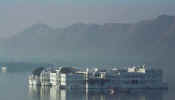 hardened
travelers. In the middle of the lake was what looked like a floating
island, totally cut off from the shore. This
was the famed Lake Palace Hotel, reputedly one of the world’s most spectacular
venues. At almost $250 for the
cheapest double room (and no lake view) we didn’t even enquire as to
availability, but it certainly looked impressive both at night and at dawn, when
the early morning light revealed a posh-looking white palace accessible only by
boat.
hardened
travelers. In the middle of the lake was what looked like a floating
island, totally cut off from the shore. This
was the famed Lake Palace Hotel, reputedly one of the world’s most spectacular
venues. At almost $250 for the
cheapest double room (and no lake view) we didn’t even enquire as to
availability, but it certainly looked impressive both at night and at dawn, when
the early morning light revealed a posh-looking white palace accessible only by
boat.
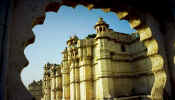 Udaipur
has been labeled by many as the Venice of the East and the most romantic city in
Rajasthan. We considered that a little
over-the-top (perhaps because we weren't staying at the Lake Palace), but
certainly
Udaipur had some worthwhile sights to uncover.
Its inhabitants were proud of the town’s heritage as a centre for the
performing arts, painting and crafts, and there were many shops selling
traditional Rajput-Mughal style miniature paintings, fascinating to peruse.
Much of the old city wall had long since disappeared but the gates still
remained and the old city itself was the usual maze of jumbled, winding streets.
Udaipur
has been labeled by many as the Venice of the East and the most romantic city in
Rajasthan. We considered that a little
over-the-top (perhaps because we weren't staying at the Lake Palace), but
certainly
Udaipur had some worthwhile sights to uncover.
Its inhabitants were proud of the town’s heritage as a centre for the
performing arts, painting and crafts, and there were many shops selling
traditional Rajput-Mughal style miniature paintings, fascinating to peruse.
Much of the old city wall had long since disappeared but the gates still
remained and the old city itself was the usual maze of jumbled, winding streets.
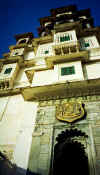 The
City Palace struck an imposing backdrop to the city skyline and was apparently
the largest palace complex in Rajasthan. The
palace itself was surmounted by balconies, towers and cupolas and was for the
most part preserved as a museum. There
were some wonderful 'movie-action' paintings depicting several stages of a
particular hunting trip within a single frame, beautiful mirror-work and
ornamental tiles.
The
City Palace struck an imposing backdrop to the city skyline and was apparently
the largest palace complex in Rajasthan. The
palace itself was surmounted by balconies, towers and cupolas and was for the
most part preserved as a museum. There
were some wonderful 'movie-action' paintings depicting several stages of a
particular hunting trip within a single frame, beautiful mirror-work and
ornamental tiles. 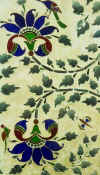
For nourishment we chose one of
the many small guesthouses boasting roof top restaurants with fine views across
Lake Pichola. Although most of
these catered to the backpacker crowd and listed banana pancakes as their number
one specialty, their traditional cuisine was well prepared and tasty.
Inspired by the views, the sunshine and the relaxing atmosphere, Pippa
and Jerry asked for a beer to wash down their lunch one day and were told that
unfortunately they did not serve beer, but would be happy to serve their 'special tea' (nudge, nudge, wink, wink).
Not getting the plot, they both picked up the menu again to find further
inspiration whereupon the waiter insisted that really, their special tea was
very good. They eventually conceded
and soon enough a teapot and two cups and saucers appeared.
Both being English and therefore accustomed to the ritual of
tea-drinking, they allowed it to steep for a while and then poured it out into
the cups. It was indeed the right
color for tea, but had a definite fizzy appearance complete with a fine head of
froth … and of course tasted exactly like beer.
On departing, we were taken aside by the proprietor who explained that it
was against the law for them to sell beer, but that as special friends we could
partake of their tea any time, as long as we didn’t spread the word!
Only in India…
Ranakpur
Wednesday 29 December 1999
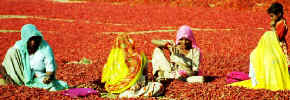 So
after another sunset and sunrise, we left Udaipur and headed onwards to Jodhpur
with a day in hand. The drive north
was spectacular. Winding through
the picturesque Rajasthani countryside, we encountered wonderful rural scenes of
camels pulling carts over-laden with hay and sand, and women dressed in brightly
coloured saris, their heads covered and one side of their faces sporting long
gold chains strung from ear to nose. Old
men dressed in white sat outside their ramshackle homes leaning on long wooden
staffs and watching the world go by, and women and girls carrying shallow
baskets scooped up fresh cattle dung off the ground with their bare hands and
then sat rolling them into flat pies which were left out to bake in the sun for
later use as fuel for the kitchen stove. The
flat countryside, encircled by hills, had been turned to agriculture, although
it was hard to imagine anything being able to grow out of this hot and dusty
land. Olive-like trees seemed to be
the only thing that grew in proliferation, battling against the drifts of sand
that were piled up against the roadside and earthen walls of the houses.
Occasionally, we spotted a peacock, blue and resplendent, or a herd of
goats nibbling at the sparse vegetation or being herded down the road by
children. It was by far the most
mesmerizing panorama we experienced in Rajasthan.
So
after another sunset and sunrise, we left Udaipur and headed onwards to Jodhpur
with a day in hand. The drive north
was spectacular. Winding through
the picturesque Rajasthani countryside, we encountered wonderful rural scenes of
camels pulling carts over-laden with hay and sand, and women dressed in brightly
coloured saris, their heads covered and one side of their faces sporting long
gold chains strung from ear to nose. Old
men dressed in white sat outside their ramshackle homes leaning on long wooden
staffs and watching the world go by, and women and girls carrying shallow
baskets scooped up fresh cattle dung off the ground with their bare hands and
then sat rolling them into flat pies which were left out to bake in the sun for
later use as fuel for the kitchen stove. The
flat countryside, encircled by hills, had been turned to agriculture, although
it was hard to imagine anything being able to grow out of this hot and dusty
land. Olive-like trees seemed to be
the only thing that grew in proliferation, battling against the drifts of sand
that were piled up against the roadside and earthen walls of the houses.
Occasionally, we spotted a peacock, blue and resplendent, or a herd of
goats nibbling at the sparse vegetation or being herded down the road by
children. It was by far the most
mesmerizing panorama we experienced in Rajasthan.
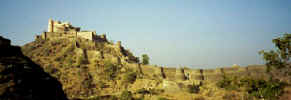 Although
the decision to stop at Kumbhalgarh fort en route had been something of a last
minute decision, it was one we were not to regret.
In fact, of all the ancient forts we visited during our trek across
India, this was the most memorable. It
was a secluded place built in the 15th century on a massive ridge
nearly 1,200 metres (4,000 feet) high, well protected from unwelcome visitors.
Although
the decision to stop at Kumbhalgarh fort en route had been something of a last
minute decision, it was one we were not to regret.
In fact, of all the ancient forts we visited during our trek across
India, this was the most memorable. It
was a secluded place built in the 15th century on a massive ridge
nearly 1,200 metres (4,000 feet) high, well protected from unwelcome visitors.
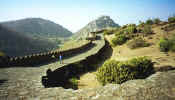 The fort ramparts were spectacular and stretched some
30 kilometres (20 miles), enclosing
many temples, palaces, gardens and water storage facilities.
The views were
breathtaking, as was the walk up the ramparts and the scramble through the bush
to uncover some of the deserted temples. We
spent more time here than we had intended, so taken in were we with the size and
feel of the place. There were many
nooks and crannies to explore and, thanks to Jerry, we also happened upon a
caretaker (or at least someone with a key) who let us in to some of the
off-limits part of the palace itself.
The fort ramparts were spectacular and stretched some
30 kilometres (20 miles), enclosing
many temples, palaces, gardens and water storage facilities.
The views were
breathtaking, as was the walk up the ramparts and the scramble through the bush
to uncover some of the deserted temples. We
spent more time here than we had intended, so taken in were we with the size and
feel of the place. There were many
nooks and crannies to explore and, thanks to Jerry, we also happened upon a
caretaker (or at least someone with a key) who let us in to some of the
off-limits part of the palace itself.
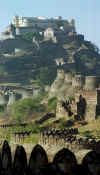
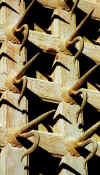
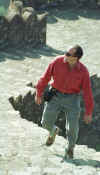
It meant that we arrived in
Ranakpur as evening was approaching, but managed nonetheless to find a bed for
the night in a small budget hotel complete with restaurant and lengthy menu
boasting all our favourite Indian delicacies.
The food was excellent and we feasted on everything from dhal
(lentils) to aalum dum (potato curry), chicken korma (curry), palak
paneer (spinach and cheese) and more, washed down with beer and accompanied
by copious numbers of rotis. Indian
food was one of the highlights of travelling through this amazing country.
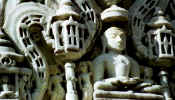 The
next day, Eric was up at the crack of dawn to photograph the temple as the sun
rose (old habits were now dying hard) while Jerry and Pippa slept.
But after breakfast (for which no-one had
The
next day, Eric was up at the crack of dawn to photograph the temple as the sun
rose (old habits were now dying hard) while Jerry and Pippa slept.
But after breakfast (for which no-one had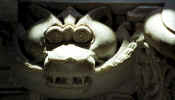 much of an appetite after the
previous night’s meal!) we all headed out together for a tour of this
remarkable marble temple.
Ranakpur
was built in 1439 and had a mere 29 halls supported by 1,444 pillars, no two
being alike. An impressive marble
staircase led up to the white marble temple, every niche, pillar and inch of
which was festooned with delicate carvings.
Within the complex were two other Jain temples,
all displaying similar carvings and all equally impressive.
much of an appetite after the
previous night’s meal!) we all headed out together for a tour of this
remarkable marble temple.
Ranakpur
was built in 1439 and had a mere 29 halls supported by 1,444 pillars, no two
being alike. An impressive marble
staircase led up to the white marble temple, every niche, pillar and inch of
which was festooned with delicate carvings.
Within the complex were two other Jain temples,
all displaying similar carvings and all equally impressive.
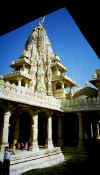
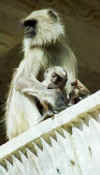 As it was a extraordinarily
important religious site, many pilgrims gathered here to make offerings and pray
and we were presented with a list of 'DON’Ts' upon purchasing our tickets,
many of which alarmed us. Along
with the
usual no shoes, no photographs, no smoking, no shorts or short-sleeved clothing,
we were advised that no leather goods were to be taken into the temple and
nothing sewn or stitched! Horrified at the thought of having to leave all our clothes outside, we
enquired further and discovered that strict disciples of the Jain religion are
prohibited from wearing stitched clothing.
Instead, they wear simple white dhotis with a shawl over their
chests. Apparently, much of the
Jain faith is based on ahimsa or non-injury, and eight days of every year
are devoted entirely to doing the right thing, whether that be remaining silent,
fasting or not even drinking water, in order to keep thoughts from wandering and
God in the center of the mind.
As it was a extraordinarily
important religious site, many pilgrims gathered here to make offerings and pray
and we were presented with a list of 'DON’Ts' upon purchasing our tickets,
many of which alarmed us. Along
with the
usual no shoes, no photographs, no smoking, no shorts or short-sleeved clothing,
we were advised that no leather goods were to be taken into the temple and
nothing sewn or stitched! Horrified at the thought of having to leave all our clothes outside, we
enquired further and discovered that strict disciples of the Jain religion are
prohibited from wearing stitched clothing.
Instead, they wear simple white dhotis with a shawl over their
chests. Apparently, much of the
Jain faith is based on ahimsa or non-injury, and eight days of every year
are devoted entirely to doing the right thing, whether that be remaining silent,
fasting or not even drinking water, in order to keep thoughts from wandering and
God in the center of the mind.